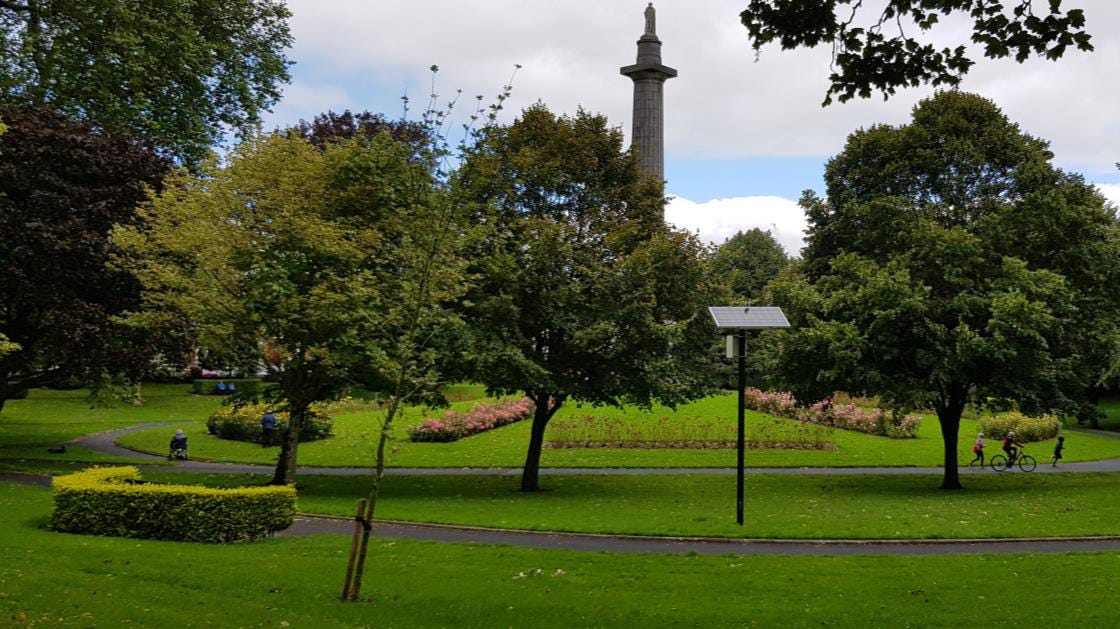Noise (and) Control
Plus some acoustic odds and ends for your enjoyment
Welcome to the June edition of CLAMOR! This month, we look into the intersections of noise and control. In an opening note, I touch on the feeling of powerlessness that fuels our visceral response to noise. Then, we dig into a partnership between Yale psychiatrists and psychics examining the concept of control for people who hear voices in research that could transform our understanding of auditory hallucinations. Finally, crowing roosters taken to court, Limerick seeks creative ways to quiet, and noise hampers a back-to-the-office push by employers.
What Can We DO?!
During a recent virtual author talk, I was asked a question in the chat that I have faced many times: What ACTIONS can we take to generally increase quietude in our environments?
It’s a reasonable question, and it seems like a simple one. But it’s not. I’ve spoken with many people around the world who have devoted years, even decades, to “increase quietude” in their environments by fighting noise of every sort—big rig trucks shortcutting through residential streets, jet overflights and helicopters, data centers, leaf blowers, excessive honking, fireworks, fracking, construction, and so forth. In every case, it was a slog and a frustrating, sisyphean struggle for control over sonic space.
The answer to “Who do I call about this?” varies tremendously from place to place and noise to noise (here’s the noise cheat sheet for Boston, for example). Then, once you’ve found the right audience for a complaint, stirring action and enforcement of noise regulations remains hit or miss.
When noise fighters win victories, it’s typically due to a combination of dogged persistence and, importantly, gaining allies. The nonprofit Quiet Communities, for instance, has spent years building a coalition to displace gas-powered landscaping tools—yes for the sake of ears, but also for lungs, for workers’ health, and the for the environment. They’ve spread the word about noise harms, but also worked with the owners of landscaper businesses to supply training and support government incentives for transitioning to quieter, cleaner electric tools. This approach is working.
I believe we get tremendous leverage from broadening the anti-noise cause. One example is the healthy buildings movement includes acoustics as one of its foundations along with factors such as like ventilation and water quality. Or take the burgeoning field of sensory ecology that’s revealing how the “sensory smog” of human noise pollution, along with artificial light, degrades wildlife habitat. Finally, after cardiologists at Massachusetts General Hospital showed how noise is a key risk factor in chronic stress and its health fallouts, they suggested that noise exposure be included in clinical assessments for heart-disease risk.
I recommend apps like SoundPrint, because they link users to a global network of people who value quiet, not only guiding them to lower-decibel venues but harnessing and amplifying consumer demand for healthier sound environments. Simply put, more allies means more effective pressure on policymakers and businesses to seek solutions. Understanding sound’s role within larger issues such as mental health and environmental justice spreads awareness of noise harms and supports proactive efforts to improve our sound environments.
Having said all that, what ACTIONS can we take? People understandably also want more practical strategems for battling the noises they’re enduring right now. Groups such as Quiet Communities have resources at their websites broken down by noise concern. The group will host a (members only) forum “Introduction to Noise & The Law” on Thursday, June 19 at 4PM.
I also want to provide more immediately helpful answers when these questions arise, and I am mulling what I can do via this newsletter. For instance, on the policy front, I’m already planning to look into the impacts of noise cameras as well as the sonic implications of congestion pricing. Beyond that, I’m considering a Q&A with a veteran leader of noise fights who can get specific about the effectively organizing against noise, or at least a listing of top anti-noise coalitions. I welcome suggestions.
The Noisy Doors of Perception
When I was researching Clamor, I let my curiosity and enthusiasm get the better of me. The book’s first draft ballooned to more than 100,000 words (400+ pages). Potential readers will be glad to know that rewrites cut that word count nearly in half. There’s much to be said for concision, and even more to be said for a clear, focused argument. But, a few of the noise darlings I killed to maintain message discipline are worthy of resurrection.
So, I was so excited to learn that the science magazine Undark publishes a regular feature called “What I Left Out” (WILO for short) where book authors highlight an interesting story they had to drop from the final draft.
My WILO was about Albert Powers, a Yale psychiatrist who works with young people who hear voices and worry they are experiencing early symptoms of psychosis. But Powers knew that a lot of people who hear voices can lead otherwise normal lives. He joined forces with high-functioning voice hearers, such as mediums, spiritualists, and practitioners of certain religious traditions to investigate the mechanisms of auditory hallucinations and whether they can be altered. The research is a mix of structured interviews and brain scans using hallucinations induced with classical conditioning—repeatedly pairing a barely audible tone with a salient visual cue, and then randomly showing only the visual cue and observing brain patterns in people who say they perceive a tone that doesn’t actually exist.
In the initial findings, published in Science in 2017, Powers and his team found that voice hearers with and without a clinical diagnosis were more likely to percieve a non-existent tone compared to control subjects who never heard voices. Plus, there was no significant difference in brain-activity patterns for people who reported hearing a tone, whether it existed or not. Finally, while control subjects were less prone to auditory hallucinations compared to voice hearers, they were not immune to them.
At this point, you may be asking: What does this have to do with normal, audible noise? The common denominator is the importance of control in our sonic experiences. In everyday sound perception, we are much more likely to tolerate or even welcome sounds we feel some control over while the lack of control is a key factor in perceiving sounds as distressing noise. And when it came to hearing voices, the research subjects diagnosed with psychosis were much more likely to feel distressed and much less likely to feel any control over the voices, compared to high-functioning voice hearers.
Powers and company have spent the last several years exploring the mechanisms of this control—what it is, how to measure it, and most importantly if/how it can be enhanced—in a project dubbed Project COPE (Influence/Control Over Perceptual Experience).
Their findings also support a bigger theory, which is that all of us hallucinate to some degree as part of normal auditory perception. Simply put, the amount of data from our ears (and all our senses) is too overwhelming and noisy for us to deal with in real time, and so our brains make predictions, using expectations from our lived experiences, to prune and marshall that barrage of inputs into a coherent and useful sensory reality as efficiently as possible.
This requires a fair amount of perceptual gap filling, with illusion where necessary. It’s how ventriloquism works, and it’s also behind phenomena such as sine-wave speech, a stripped-down version of a human voice in which all the acoustic elements have been removed except changes of frequency and amplitude. The end result is an eerie robotic whistling, like R2D2 with a cold. But, after listening to the original, intact voice recordings once or twice, the whistles suddenly become intelligible. Your expectant brain conjures the missing consonants and vowels, forging a signal from what was previously just noise.
Just for fun, I took one of Project COPE’s published papers about auditory hallucinations, and I fed it into Google’s Notebook LM, which uses AI razzle dazzle to transform dense text like this into a podcast conversation between two artificially generated cohosts. The result doesn’t get too deep into the details, and it includes some odd repetitions and a few too many “oh wow!” reactions. Still, the overall results are still pretty amazing. Have a listen:
Wait…What?!
Acoustic Odds and Ends
A recent story about rooster noise being litigated in an English courtroom caught my eye (the case dragged on for about three years and cost the animal’s owner nearly $4500). I recalled the story of Maurice, a French rooster that became a cause célèbre in 2019 when a couple bought a vacation home in a rural area of Western France and proceeded to lodge a legal case to silence their neighbor’s rooster. Not only did a French court toss the case, but after another rooster, Marcel, was shot to death by noise-disturbed neighbors, the uproar led to a new law protecting the “sensory heritage” of rural France—from the sound of cowbells to the odor of cow droppings, and yes, rooster crows.

Maurice and his owner Corinne Fesseau. The rooster died in 2020, a year after complaints about his crowing led to a new law protecting the sensory heritage of the French countryside. Photograph: Xavier Leoty/AFP/Getty Images. These cases also reminded me of a fascinating article about the era of European history when animal owners didn’t face court judgment but the animals themselves did—pigs, dogs, and bears were tried on charges of murdering and maiming humans while rats were tried for stealing grain. The article mentions only one rooster to face justice, and it wasn’t for disturbing the peace, but rather for somehow laying an egg, which locals took as a sign of demonic possession. The rooster was found guilty and put to death.
In Limerick, Ireland, they plan to make a popular park feel quieter by adding sound. Many parts of People’s Park are quiet in the old-fashioned way (i.e. low-decibels). But, there are a couple areas where noise from the abutting busy roadways infiltrates the park and disturbs visitors. So, Limerick’s Environment and Arts departments are jointly commissioning sound art for the sonically disturbed areas to create “audio islands” that will mask the roadway noise and make the place a more pleasant and “quiet” place for visitors. The Limerick City and County Council issued an artist brief that described the park’s existing soundscape using data from soundwalks and copious acoustic measurments. The deadline for submitting sound art proposals is June 25. The concept of adding sound to enhance a feeling of quiet has been proven in other cities, such as Montreal and Berlin. I plan to write more about Limerick’s efforts in a future post.
Office noise is fueling worker resistance to a push from employers to end hybrid and work-from-home arrangements, according to a report in last month’s Facilities Management Journal. The article detailed the results of a survey of more than 2,000 office professionals in the UK, in which 36 percent said that they worked from home to escape the noise, and nearly half said they struggled to concentrate when working in the office due to the din. The report echoed similar noise-based resistance to an office return covered by Fast Company magazine and the radio show Marketplace.
#ClamorDogs for June prefers digital reading.
Thanks so much for reading CLAMOR! Please spread the word and subscribe for free to receive new posts and support my work.





